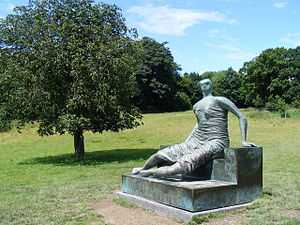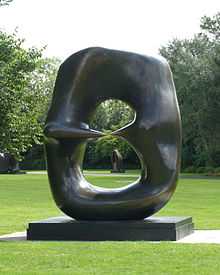Draped Seated Woman 1957–58
 | |
| Artist | Henry Moore |
|---|---|
| Year | 1957-8 |
| Type | Bronze |
| Dimensions | 185.5 cm (73.0 in) |
Draped Seated Woman 1957–58 (LH 428) is a bronze sculpture by British artist Henry Moore, made in a series of six castings in the 1950s. The sculpture depicts a female figure resting in a seated position, with her legs folded back to her right, her left hand supporting her weight, and her right hand on her right leg. The drapery emphasises the female figure, but the facial features are abstracted and barely picked out.
Background
Henry Moore was a war artist in the Second World War. He made a series drawings of people in London sheltering from the Blitz in the Underground, swathed in thick clothes. These drawings sparked an interest in drapery which was renewed by the classical sculptures that Moore saw during a trip to Greece in 1951. He was attracted by the ability of the drapery to draw attention to some parts of the human form by lying tightly on the shoulders, thighs or breasts while concealing other parts where the wrapping falls slack, and also by the varied textures created by small and large folds in the material.
Moore make a series of sculptures of draped human forms in the 1950s after he was commissioned to create a sculpture for the new UNESCO Headquarters building in Paris. He wanted to create a figure in an architectural context, and turned to the seated human form. The first work in the series in 1955 was a maquette, Draped Seated Woman: Figure on Steps (LH 427), cast in a series of 10. This became the working model for the full-size sculpture that became his Draped Seated Woman 1957–58. He also made a similar work Draped Reclining Woman 1957-58. Moore ultimately abandoned these ideas for the UNESCO commission, and his UNESCO Reclining Figure 1957-58 (LH 416) is a much more abstract reclining form in travertine.
Sculpture
Moore's sculpture depicts a female figure in a seated position. It measures approximately 2 metres (6 ft 7 in) long, 2.5 metres (8 ft 2 in) tall, and weighs approximately 1 tonne (1.1 tons). It is usually displayed mounted on a flat seat with raised arms to either side.
Six casts of the completed sculpture were made, which are currently displayed in the UK, Germany, Israel, America, Australia and Belgium:
- the Von der Heydt Museum at Wuppertal in Germany (now redisplayed at the Wuppertaler Schwimmoper)
- the National Gallery of Victoria at Melbourne in Australia
- the Jewish National and University Library at Jerusalem in Israel
- the Musée d'Art Moderne at Brussels in Belgium
- the Yale University Art Gallery at New Haven, Connecticut
- Tower Hamlets London Borough Council in the United Kingdom (displayed at the Yorkshire Sculpture Park since 1996?).
The German cast (Die Sitzende) was bought for a new swimming pool in Wuppertal, the Wuppertaler Schwimmoper. It generated very negative reaction from the German public when it went on display. Overnight from 5–6 December 1958, the cast was tarred and feathered, and an anonymous letter was left suggesting that the metal would be better used to make 100 frying pans. The derision continued, and the city authorities eventually donated the sculpture to the Von der Heydt Museum in 1963, and it relocated in September 1966. It went in to storage in 1997 while the building was renovated, and returned to the swimming pool in 2010.
The UK cast was sold to London County Council in 1962 for £6,000, less than the market price, because Moore – a confirmed socialist – wanted a sculpture to be displayed in public in the East End of London. The sculpture was installed outside Ewhurst Tower, a residential tower block on the Stifford Estate in Stepney. Nicknamed "Old Flo", it remained at the same site for 35 years from early 1963 until the estate was demolished in the late 1990s. It has been on loan to Yorkshire Sculpture Park since 1997. The sculpture was inherited by the Greater London Council in 1965 and then by Tower Hamlets London Borough Council when the GLC was abolished in 1986. Controversial proposals for the council to sell the sculpture at auction in 2013 for an estimated £20m were suspended after a public outcry, and claims that the sculpture belongs to Bromley London Borough Council instead.[1]
Gallery
-
Tate Britain
-
Jerusalem
References
- ↑ "Old Flo's ownership questioned". Henry Moore Foundation. 3 January 2013. Retrieved 14 January 2013.
External links
- Casts
- Draped Seated Woman 1957–58 (LH 428), Von der Heydt-Museum, Wuppertal, Henry Moore Foundation
- Draped Seated Woman 1957–58 (LH 428), National Gallery of Victoria, Melbourne, Henry Moore Foundation
- Draped Seated Woman 1957–58 (LH 428), Musee d Art moderne, Brussels, Henry Moore Foundation
- Draped Seated Woman 1957–58 (LH 428), Jewish National and University Library, Jerusalem, Henry Moore Foundation
- Draped Seated Woman 1957–58 (LH 428), Yale University Art Gallery, New Haven, Henry Moore Foundation
- Draped Seated Woman ("Old Flo") and London, Museum of London
- Working Model for Draped Seated Woman: Figure on Steps 1956 (LH 427), Aberdeen Art Gallery, Henry Moore Foundation
- Henry Moore, Woman Seated in the Underground, 1941, Tate Gallery
- Henry Moore, Maquette for Figure on Steps 1956, Tate Gallery
- Henry Moore sculpture may be sold by Tower Hamlets council, The Guardian, 3 October 2012
- Museum of London offers council's Henry Moore sculpture a new home, The Guardian, 5 November 2012
- Tower Hamlets to sell Moore sculpture, Henry Moore Foundation, 15 November 2012
- Henry Moore's Draped Seated Woman: timeline of events, The Art Fund
- Henry Moore sculpture decision raises fears for public art, The Guardian, 7 November 2012
- New twist in row over ownership of Henry Moore's 'Old Flo', The Guardian, 19 December 2012
- Henry Moore’s ‘Old Flo’ sculpture withdrawn from auction, London24, 21 December 2012
- Statement: Henry Moore's Draped Seated Woman, The Art Fund, 29 November 2012
- Draped Seated Woman: Figure on Steps, Christie's
- Wanderschaft der Sitzenden endet in der Schwimmoper, Westdeutsche Zeitung, 15 November 2010 (German)
- Sitzende Stadtteil Elberfeld
- Draped Seated Woman, Yale University Art Gallery
- Draped seated woman, National Gallery of Victoria


